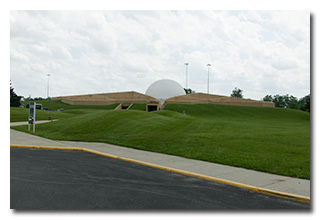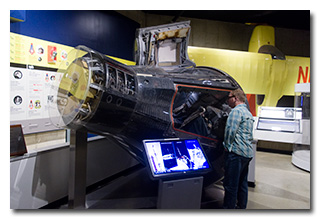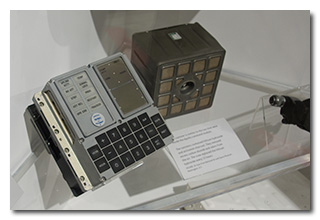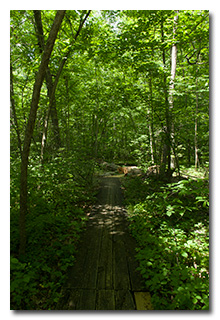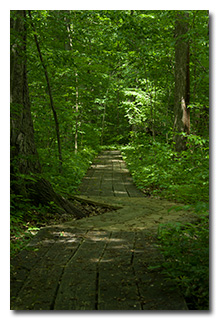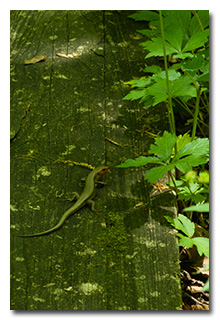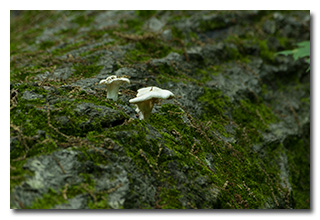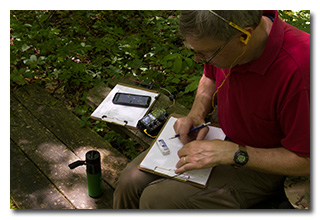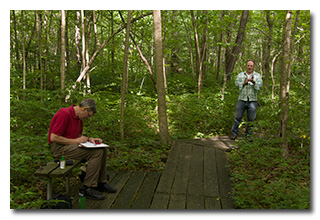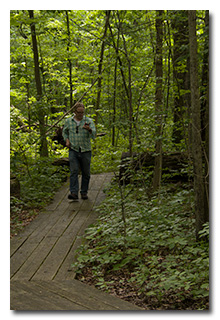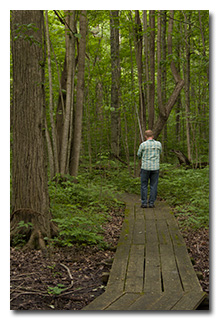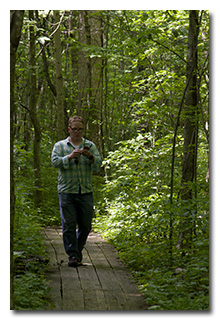
by William Eric McFadden
From the Armstrong Air & Space Museum's website:
-
On July 20, 1969, the world watched with anticipation as Apollo 11 astronaut Neil Armstrong exited the lunar module and took humanity's first historical step on the Moon. This monumental "giant leap" is undoubtedly one of the most significant and unifying achievements in human history. Today, one major site for preserving this story and America's rich heritage in space exploration is the Armstrong Air & Space Museum, located in Armstrong's hometown of Wapakoneta, Ohio.
From the nature preserve's website:
-
Although small in size, Gross Memorial Woods is one of the least disturbed old-growth woods in west-central Ohio and one of the few mixed-species swamp forests remaining in this part of the state.
The woods are characterized by a diversity of tree species, with no one type being dominant. Large bur oaks and basswood occur in the wettest areas, with shagbark hickory, white and red oaks, black walnut, beech and sugar maple on slightly drier ground. The rare pumpkin ash is also present here. The display of spring wildflowers and the brilliance of autumn colors makes visiting Gross Memorial Woods rewarding at any season.
Pictures
- The Armstrong Air & Space Museum: 1 | 2 | 3
- The Gross Memorial Woods State Nature Preserve sign; photo by Miles McFadden
- The boardwalk hiking trail: 1 | 2; photos by Miles McFadden
- A skink; photo by Miles McFadden
- Eric operating; photo by Miles McFadden
- Mushrooms: 1 | 2 | 3; photos by Miles McFadden
- Thomas operating /PM: 1 | 2 | 3; photos by Miles McFadden
- Eric and Thomas; photo by Miles McFadden
Description
On Monday, May 20, 2024, three members of the Southeast Ohio Radio Adventure Team performed successful activations of Gross Memorial Woods State Nature Preserve (US-9410) in Ohio as part of the Parks on the Air (POTA; link) program.
After spending Thursday, Friday, and Saturday at Hamvention (link) and QRP ARCI's Four Days in May (link), and after Sunday activations of Pater Wildlife Area (link) and Whitewater Canal State Historic Site (link), Eric McFadden, WD8RIF; Thomas Witherspoon, K4SWL; and Miles McFadden, KD8KNC, finally pointed their motorized transport east to begin the drive to their respective homes. First, though, a detour to the Armstrong Air & Space Museum in Wapanoketa (link) was in order, and then an activation of Gross Memorial Woods State Nature Preserve.
The Armstrong Air & Space Museum turned out to be a spectacular museum describing the life and achievements of Neil Armstrong, and included exhibits about Gemini 8 mission and his Apollo 11 landing on the moon.
After the museum tour, and following lunch with far too much food at Al's Woody's Diner in Wapakoneta, the trio made the short drive to Gross Memorial Woods State Nature Preserve.
Upon arrival at Gross Memorial Woods and seeing the boardwalk hiking trail which makes a 0.6-mile loop through the small swamp forest nature preserve, Thomas declared he would operate pedestrian mobile ("/PM") using his Elecraft KH1 transceiver in the mode for which it was designed. Knowing that there was at least one bench along the trail, Eric decided to hike until he found a suitable bench, and he would set up his Elecraft KX2 station there. Miles would not operate but would do most of the activation photography.
The hike along the boardwalk was easy and lovely, the only problem being the very large population of mosquitoes. Thomas had wisely applied insect repellent to his whole body before begininning the hike but Eric, initially concerned only about ticks, had only sprayed his pant legs and was, therefore, quite vulnerable to mosquitoes on his arms, neck, and face. (Indeed, after he found the bench on which was going to operate, Eric asked Miles to return to the car to fetch the insect repellent so he better armor himself against the mozzies.) Along the boardwalk, numerous skinks were seen before they slipped under the boardwalk, and numerous kinds of birds were heard even if they couldn't be easily seen.
It turned out the boardwalk hiking trail featured two benches. Eric chose the second of the benches and set up his station, placing his KX2 on the bench and sloping his Tufteln (link) 35' end-fed random wire antenna up to the top of his Goture Red Fox Super Hard 720 carbon-fiber mast supported on a spike stuck into the moist soil adjacent to the trail. For this operation, Eric deployed a single 17' counterpoise wire instead of his usual three, laying the wire on the ground adjacent to the boardwalk, arranged so it would not be a trip hazard. Eric was on the air at 1843 UTC.
Immediately upon turning on his KX2, Eric could hear evidence of Thomas's 20m signal on the band. As soon as he was able to identify Thomas's frequency, Eric called him and completed a P2P QSO with him at 1843 UTC.
After working Thomas on 20m, Eric found a clear frequency on 17m, began calling "CQ POTA", and spotted himself on POTA Spots, but HF conditions were rough and no QSOs were made. After nine minutes of working no one, he noticed that Thomas had switched to 17m, so at 1852 UTC, Eric found him on that band and completed a second P2P QSO with Thomas.
With Thomas now on 17m, Eric found a clear frequency on 20m to run, hopefully began calling "CQ POTA", and was auto-spotted on POTA Spots. However, as before, no one responded to his calls. After about ten minutes of no QSOs, he noticed that Thomas had moved to 30m, so at 1902 UTC, Eric found him on that band and completed a third P2P QSO with Thomas.
Deciding to give 40m a try, Eric found a clear frequency to run, began calling "CQ POTA", and self-spotted himself on POTA Spots. This time, Eric found some limited success. Eric's first QSO in this run came at 1906 UTC with W4VIG in Virginia. This was followed at 1907 UTC by a QSO with K8ETA in Ohio. Interference from digital stations forced Eric to change frequency slightly, and he was auto-spotted on POTA Spots with the new frequency, but fifteen minutes of calling resulted in no additional QSOs.
At 1924 UTC, Eric noticed that Thomas had moved to 15m, so Eric found him on that band and completed his fourth P2P QSO with Thomas.
Giving 17m another try, Eric called CQ for about fifteen minutes with no success.
Having had little success running a frequency, Eric decided to hunt for P2P QSOs and he had some success on 20m. At 1939 UTC, Eric completed a P2P QSO on 20m with VA2IDX who was activating Mont-Saint-Bruno National Park (CA-0508) in Quebec. At 1957 UTC, Eric completed a P2P QSO on 20m with N0ANE who was performing a two-fer activation of Minnesota Valley State Recreation Area (US-7145) and Minnesota Valley State Trail (US-9384) in Minnesota. At 2000 UTC, Eric completed a P2P QSO on 20m with VE6LK who was activating Lloyd Creek Natural Area (CA-3067) in Alberta. It was during this period of hunting that Eric saw a raccoon pass by about 75' away, and Thomas reported smelling signs of a skunk nearby on other portions of the trail.
Returning to 40m, Eric's calls actually resulted in some QSOs. His first QSO in this run came at 2020 UTC with KA8SYV in West Virginia. This was followed at 2023 UTC by a QSO with K3ES in Pennsylvania; K3ES, normally a QRPer, admitted that band conditions were so rough that he was running high power for this QSO. Finally, at 2026 UTC, Eric completed a fifth P2P QSO with Thomas.
In all, Eric made twelve QSOs, with nine P2P QSOs, only four of which were not Gross Memorial Woods State Nature Preserve. All of Eric's QSOs were CW and were made with five watts output.
For his activation, Thomas walked about four miles while making three or four complete circuits of the roughly circular boardwalk hiking trail, operating his KH1 in true /PM mode. He managed to work ten stations to validate his activation in about an hour but operated for 105 minutes in total and made sixteen QSOs.
Thomas's complete report is available here: Elecraft KH1 in Motion: Proper Pedestrian Mobile Activation in Ohio State Nature Preserve.
(return)
